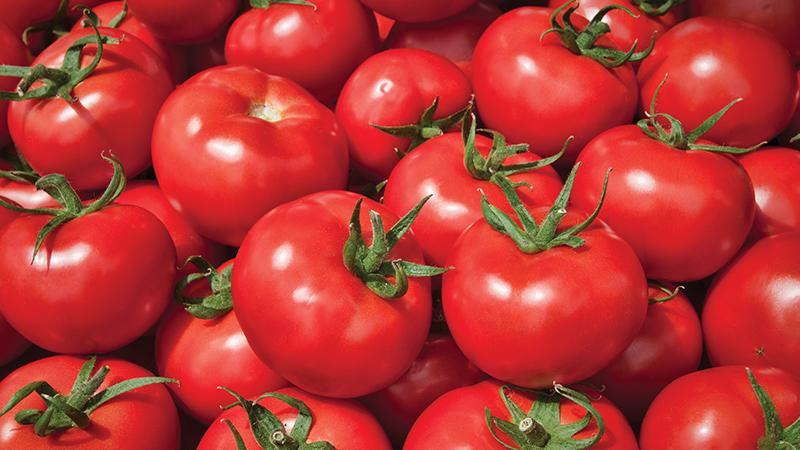The Evolution of Mechanical Blossom Thinning in Peaches
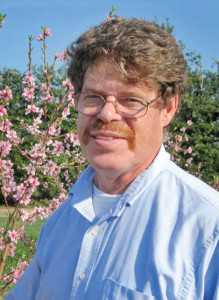 Mechanical blossom thinning was introduced to the peach industry in the last decade and we are still learning how to use this new technology. Although the change will be gradual, these new devices will have a profound effect on how peaches are grown. The concept of blossom thinning is straightforward — removing excess blossoms saves nutrients so the remaining blossoms can develop into larger fruit.
Mechanical blossom thinning was introduced to the peach industry in the last decade and we are still learning how to use this new technology. Although the change will be gradual, these new devices will have a profound effect on how peaches are grown. The concept of blossom thinning is straightforward — removing excess blossoms saves nutrients so the remaining blossoms can develop into larger fruit.
Growers in frost-prone areas are often leery of blossom thinning for fear that a late freeze may reduce blossom-thinned trees to lower than desired fruit numbers. However, many growers are willing to take the risks of blossom thinning for reducing fruit loads of varieties that produce abundant bloom, have a tendency for small fruit, and/or are difficult to hand thin as small fruit.
Mechanical Thinning
Mechanical blossom thinning is the newest of many methods developed over the years for reducing flower numbers, including caustic chemicals, growth regulators, dragging ropes, hand-held brushes, gloved hands, and water streams. Of these, dragging ropes and hand-held brushes have been most commonly used, but neither is used much by the commercial fruit industry. Dragging ropes through the canopy does a very uneven thinning job and is tough on tree limbs, and labor costs are high with hand-held brushes. Mechanical string thinners, on the other hand, have the promise of more uniform thinning, less damage to trees, and reduced labor costs.
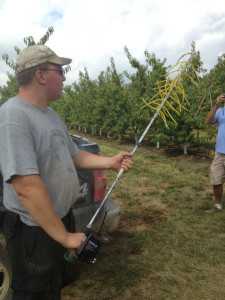
Cinch blossom thinner. (Picture courtesy of Bill Shane)
Mechanical string thinners come in several forms but all basically work the same. Two basic designs are used — a hand-held battery-powered rotating rod with strings, and a vehicle-mounted spinning rod or rods with strings. Hand-held versions include Washington State University’s string thinner, the “Electro’flor” made by the French company Infaco, and the Cinch string thinner developed in Michigan by Phil Miller. [Photo 1].
Vehicle-mounted string thinners include the Darwin with a vertically orientated rod, the Darwin PT250 with a rod that goes from vertical to horizontal, and Darwin Pro [Photo 2] designed to mount on a hedger arm (all from Germany), and the Bonner three-arm device developed at the University of Bonn by Michael Blanke. Researchers, equipment companies, and a few growers with mechanical know-how are actively evaluating and refining these designs.
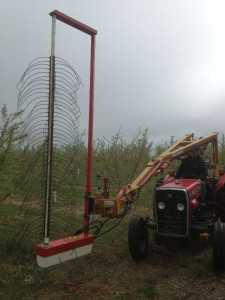
Vehicle-mounted string thinners (like this Darwin Pro blossom thinner mounted on Gillison hedger) can offer more uniform thinning than traditional methods.
(Picture courtesy of Bill Shane)
Pros And Cons
Each design has its advantages and disadvantages. Hand-held mechanical thinners can remove blossoms in the interior of a tree much more effectively than a machine-mounted device. Rotating strings of the various mechanical thinners, especially, the vehicle-mounted versions, can reach effectively only into the first foot or two of a peach canopy. Machine-mounted devices are not well-suited to traditional open-center trees with irregular structures and deeper canopies. The relatively low cost of the hand-held devices is attractive, and the operator is able to adjust the intensity of thinning immediately as needed for each tree. The downside of the hand-held devices is operator fatigue, wear and tear on the devices, and the difficulties of providing power by batteries or cords for long hours of operation.
We are seeing a slow evolution in the design and training of peach orchards to make them more accessible to mechanical thinning. Tree training systems such as palmette, Y, and quad are attractive for vehicle-mounted string thinners as they have narrow flat production surfaces suited to the shallow penetration of the strings. Training these tree wall systems is easier said than done because of the tendency of peach trees to lean, twist, and grow limbs in the wrong direction, particularly in windy sites. Hand-held string thinners are preferred for irregular tree forms such as open center, central leader, and others with limbs that stick out into the drive row. Early researchers learned that the Darwin’s whirling strings can easily strip all blossoms from limbs jutting out into the drive lane. They also learned quickly that the strings of this device can become entangled with strapping that some orchardists use to support limbs with full crop loads.
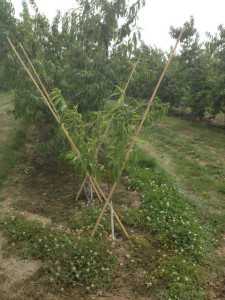
Growers are starting to build orchards suited to vehicle-mounted string thinners using techniques such as bamboo or metal conduit poles embedded in the ground as temporary training aides.
(Picture courtesy of Bill Shane)
Growers are starting to build orchards suited to vehicle-mounted string thinners using techniques such as bamboo or metal conduit poles embedded in the ground as temporary training aides in years two and three for establishing straight scaffold limbs in the desired direction. [Photo 3]
Making Fruiting Wood Available
Another technique to help ensure that most flowers are in reach of strings is to develop a system of semi-permanent stubs with fruiting wood (so-called “hangers”) close to scaffolds. [Photo 4]
To accomplish this, heading cuts of one-to-three-year-old limbs are needed within approximately four inches of the supporting scaffold.
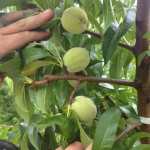
Stub cuts keep new growth and fruit close to supporting scaffolds and in reach of strings.
(Picture courtesy of Bill Shane)
The timing of these stub cuts depends on the length of the growing season. Stub cuts can be made soon after harvest for regions with long growing seasons or early ripening varieties. For areas with short growing seasons, stub cuts should be done much earlier, usually before bloom, to allow sufficient time for growth of new fruiting wood for next season. Hedging tree walls helps maintain a flat surface, and the temporary use of strapping to maintain fruit-laden scaffolds at the proper angle is useful, as well. [Photo 5]

Strapping hold scaffolds in an upright position to help with string thinners.
(Picture courtesy of Bill Shane)







